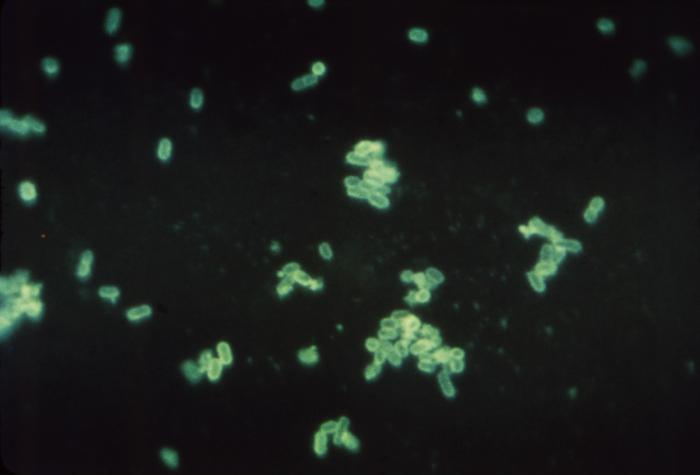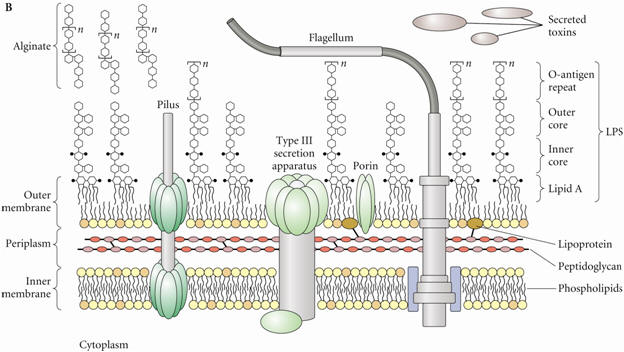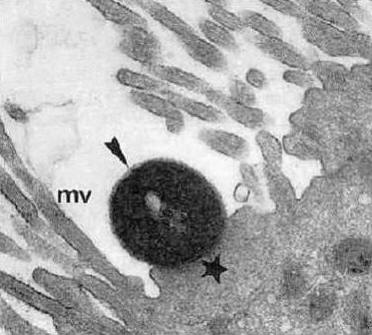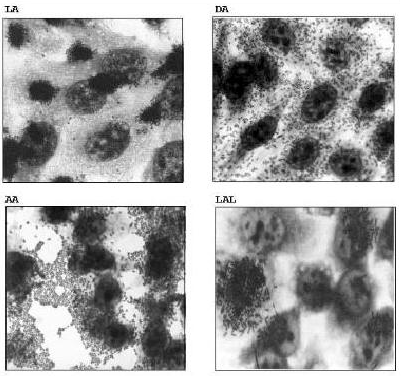Enteropathogenic Escherichia coliOverview: Enteropathogenic Escherichia coli (EPEC) is one of the five virotypes (classes) of pathogenic E. coli and is known to be the cause of diarrheal diseases. Nonpathogenic E. coli is a Gram-negative, rod-shaped bacterium (appears as red/pink colored rods upon Gram staining), known for its ability to extensively colonize the gastrointestinal tract of warm-blooded mammals and serve the useful task of keeping other bacterial organisms in check (Figure 1). No E. coli is capable of sporulating. Figure 1. Magnified 600X, this fluorescent antibody stained photomicrograph revealed the presence of enteropathogenic Escherichia coli bacteria, which were found in a fecal smear from an infant with diarrhea. E. coli is a member of the family of bacterial organisms within the family Enteribacteriaceae, and contains the highly pathogenic strain, which has been given the label O157:H7. EPEC forms microcolonies on the surface of the intestinal epithelial cells (Ochoa et al., 2008); individual bacterial cells have the length of approximately 2 μm and a diameter of 0.5 to 0.7 μm. It is considered to be a non-invasive pathogen and employs type three secretion system (T3SS) to deliver its proteins into the host epithelial cells (Dean & Kenny, 2009) (Figure 2). EPEC is a facultative anaerobe (as all members of the order Enterobacteriales); in anaerobic conditions it is capable of obtaining energy either by means of fermentation or by anaerobic respiration (with NO3, NO2 and fumarates serving as final electron acceptors instead of O2). EPEC, as opposed to many other species of E. coli, lack fimbriae. It is known to express type IV pili, instead, which are associated with the twitching motility of this pathogenic strain. Figure 2. Many bacteria use Type-III secretion systems to inject toxins into host cells (Pier et al., 2002). Click to enlarge. Virulence and Pathogenicity: Key virulence factors of this pathogen – plasmid encoded protein EPEC adherence factor (EAF), which allows for adherence of the bacteria to the intestinal cell walls. Another adhesion factor that serves as a virulence factor as well is called intimin (a non-fimbria adhesion) and is responsible for the final stages of adherence. EPEC is responsible for creation of characteristic lesions at the sites of adhesion to GI tract (Figure 3, 4). Figure 3. Attaching and effacing lesion showing effacement of microviili (mv) and pedestal (star) with adherent EPEC (arrow). Main mode of pathogenic action is being linked with EPEC’s interference and disruption of the normal host signal transduction, but not a toxin. production (the process of cell adhesion is also named as a reason for pathogenic effects of the strain); EPEC when attached to the intestinal epithelial cells is also capable of causing inflammation at sites. The process of cell adherence is very characteristic and involves very active recruitment, restructuring and polymerization of the host cell’s actin at the site of attachment (pedestal) by the bacterial cell – phenomenon has been named 'attaching and effacing' (Figure 3, 4). Figure 4. Adherence patterns of enteropathogenic E. coli (EPEC) strains. Localized adherence (LA), diffuse adherence (DA), aggregative adherence (AA), and localized adherence-like (LAL). [100 X]. (Trabulsi et al., 2002). Clinical Infections and Diagnostics: EPEC is known to cause watery and/or bloody diarrhea (dysentery), which is a main cause of diarrhea in children in developing countries (mainly under two years of age); infection usually occurs via consumption of improperly treated drinking water and sometimes meat products. Transmission of EPEC has been also reported by contact with domestic animals. The most widely used diagnostic techniques for EPEC include the use of monoclonal antibodies against Bfp, the pili expressed by EPEC used by the pathogen for adhesion purposes). Remarkably, Bfp genes of EPEC have been shown to be 100% specific to this pathogen and could not be PCR amplified in any other known bacterial enteropathogens. More trivial symptoms of the disease (diarrhea, commonly lasting for as long as two weeks, often with blood) can be used to identify the EPEC as a possible cause of the condition. References: Dean, P., & Kenny, B. (2009). The effector repertoire of enteropathogenic E.coli: ganging up on the host cell. Current Opinion in Microbiology, 12(1-3): 101-109. Ochoa, T.J., Barletta, F., Contreras, C., & Mercado, E. (2008). New insights into the epidemiology of enteropathogenic Escherichia coli infection. Transactions of the Royal Society of Tropical Medicine and Hygiene, 102(9): 852-856. Trabulsi, L.R., Keller, R., & Gomes, T.A.T (2002). Typical and atypical enteropathogenic Escherichia coli. Emerging Infectious Diseases, 8(5). |





